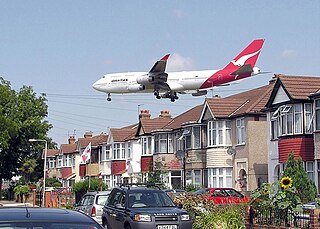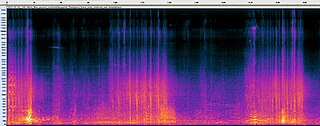The decibel is a relative unit of measurement equal to one tenth of a bel (B). It expresses the ratio of two values of a power or root-power quantity on a logarithmic scale. Two signals whose levels differ by one decibel have a power ratio of 101/10 or root-power ratio of 101⁄20.

In atmospheric sounding and noise pollution, ambient noise level is the background sound pressure level at a given location, normally specified as a reference level to study a new intrusive sound source.

A weighting filter is used to emphasize or suppress some aspects of a phenomenon compared to others, for measurement or other purposes.

Noise is unwanted sound considered unpleasant, loud, or disruptive to hearing. From a physics standpoint, there is no distinction between noise and desired sound, as both are vibrations through a medium, such as air or water. The difference arises when the brain receives and perceives a sound.
Signal-to-noise ratio is a measure used in science and engineering that compares the level of a desired signal to the level of background noise. SNR is defined as the ratio of signal power to noise power, often expressed in decibels. A ratio higher than 1:1 indicates more signal than noise.
The total harmonic distortion is a measurement of the harmonic distortion present in a signal and is defined as the ratio of the sum of the powers of all harmonic components to the power of the fundamental frequency. Distortion factor, a closely related term, is sometimes used as a synonym.

Noise pollution, or sound pollution, is the propagation of noise or sound with ranging impacts on the activity of human or animal life, most of which are harmful to a degree. The source of outdoor noise worldwide is mainly caused by machines, transport and propagation systems. Poor urban planning may give rise to noise disintegration or pollution, side-by-side industrial and residential buildings can result in noise pollution in the residential areas. Some of the main sources of noise in residential areas include loud music, transportation, lawn care maintenance, construction, electrical generators, wind turbines, explosions and people.

Dynamic range compression (DRC) or simply compression is an audio signal processing operation that reduces the volume of loud sounds or amplifies quiet sounds, thus reducing or compressing an audio signal's dynamic range. Compression is commonly used in sound recording and reproduction, broadcasting, live sound reinforcement and in some instrument amplifiers.

Audio system measurements are a means of quantifying system performance. These measurements are made for several purposes. Designers take measurements so that they can specify the performance of a piece of equipment. Maintenance engineers make them to ensure equipment is still working to specification, or to ensure that the cumulative defects of an audio path are within limits considered acceptable. Audio system measurements often accommodate psychoacoustic principles to measure the system in a way that relates to human hearing.
Comfort noise is synthetic background noise used in radio and wireless communications to fill the artificial silence in a transmission resulting from voice activity detection or from the audio clarity of modern digital lines.

The process of weighting involves emphasizing the contribution of particular aspects of a phenomenon over others to an outcome or result; thereby highlighting those aspects in comparison to others in the analysis. That is, rather than each variable in the data set contributing equally to the final result, some of the data is adjusted to make a greater contribution than others. This is analogous to the practice of adding (extra) weight to one side of a pair of scales in order to favour either the buyer or seller.

Background noise or ambient noise is any sound other than the sound being monitored. Background noise is a form of noise pollution or interference. Background noise is an important concept in setting noise levels.
In acoustics, noise measurement can be for the purpose of measuring environmental noise or measuring noise in the workplace. Applications include monitoring of construction sites, aircraft noise, road traffic noise, entertainment venues and neighborhood noise. One of the definitions of noise covers all "unwanted sounds". When sound levels reach a high enough intensity, the sound, whether it is wanted or unwanted, may be damaging to hearing. Environmental noise monitoring is the measurement of noise in an outdoor environment caused by transport, industry and recreational activities. The laws and limits governing environmental noise monitoring differ from country to country.

In electronics, noise is an unwanted disturbance in an electrical signal.

A sound level meter is used for acoustic measurements. It is commonly a hand-held instrument with a microphone. The best type of microphone for sound level meters is the condenser microphone, which combines precision with stability and reliability. The diaphragm of the microphone responds to changes in air pressure caused by sound waves. That is why the instrument is sometimes referred to as a sound pressure level meter (SPL). This movement of the diaphragm, i.e. the sound pressure, is converted into an electrical signal. While describing sound in terms of sound pressure, a logarithmic conversion is usually applied and the sound pressure level is stated instead, in decibels (dB), with 0 dB SPL equal to 20 micropascals.
Audio noise measurement is a process carried out to assess the quality of audio equipment, such as the kind used in recording studios, broadcast engineering, and in-home high fidelity.

A-weighting is the most commonly used of a family of curves defined in the International standard IEC 61672:2003 and various national standards relating to the measurement of sound pressure level. A-weighting is applied to instrument-measured sound levels in an effort to account for the relative loudness perceived by the human ear, as the ear is less sensitive to low audio frequencies. It is employed by arithmetically adding a table of values, listed by octave or third-octave bands, to the measured sound pressure levels in dB. The resulting octave band measurements are usually added to provide a single A-weighted value describing the sound; the units are written as dB(A). Other weighting sets of values – B, C, D and now Z – are discussed below.

An audio analyzer is a test and measurement instrument used to objectively quantify the audio performance of electronic and electro-acoustical devices. Audio quality metrics cover a wide variety of parameters, including level, gain, noise, harmonic and intermodulation distortion, frequency response, relative phase of signals, interchannel crosstalk, and more. In addition, many manufacturers have requirements for behavior and connectivity of audio devices that require specific tests and confirmations.
In signal processing, noise is a general term for unwanted modifications that a signal may suffer during capture, storage, transmission, processing, or conversion.
Noise refers to many types of random, troublesome, problematic, or unwanted signals.